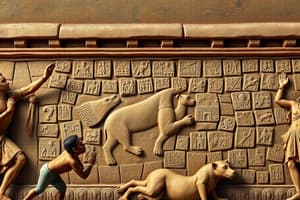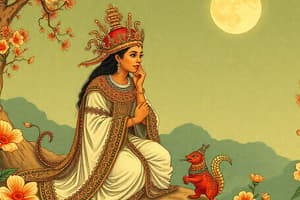Podcast
Questions and Answers
Who established the Shunga Empire by assassinating the last Mauryan emperor?
Who established the Shunga Empire by assassinating the last Mauryan emperor?
- Pushyamitra Sunga (correct)
- Agnimitra
- Vasudeva Kanva
- Brihadratha
Which dynasty succeeded the Shunga Empire after the decline?
Which dynasty succeeded the Shunga Empire after the decline?
- Kanva Dynasty (correct)
- Mauryan Dynasty
- Satavahana Dynasty
- Yavana Dynasty
During which ruler's reign did the Shunga Empire engage in battles against the Yavanas, Kalinga, and Satavahana?
During which ruler's reign did the Shunga Empire engage in battles against the Yavanas, Kalinga, and Satavahana?
- Agnimitra (correct)
- Brihadratha
- Pushyamitra Sunga
- Devabhuti
Who succeeded Pushyamitra Sunga as the ruler of the Shunga Empire?
Who succeeded Pushyamitra Sunga as the ruler of the Shunga Empire?
What field of art flourished during the Shunga Empire's rule?
What field of art flourished during the Shunga Empire's rule?
What was a notable example of artistic expression during the Shunga Empire?
What was a notable example of artistic expression during the Shunga Empire?
What event marked the rapid decline of the Shunga Empire?
What event marked the rapid decline of the Shunga Empire?
What was the political structure of the Shunga Empire?
What was the political structure of the Shunga Empire?
What was the impact of Pushyamitra Sunga's rule on Buddhism?
What was the impact of Pushyamitra Sunga's rule on Buddhism?
What was the legacy of the Shunga Dynasty?
What was the legacy of the Shunga Dynasty?
How did the Shunga rulers maintain royal power?
How did the Shunga rulers maintain royal power?
What type of literary works were produced during the Shunga Empire?
What type of literary works were produced during the Shunga Empire?
Flashcards are hidden until you start studying
Study Notes
Shunga Dynasty
Introduction
The Shunga Empire, also known as the Sunga Empire, was a Magadhan dynasty that ruled northern central and eastern India from approximately 185 BCE to 73 BCE. Established by Pushyamitra Sunga, who seized power after assassinating the last Mauryan emperor, Brihadratha, the Shunga Empire inherited the vast territories of the Mauryan Empire. This article explores the history, art and culture, religion, political structure, and legacy of the Shunga Empire.
History of the Shunga Dynasty
Founding and Expansion
The Shunga Empire was established in 185 BCE when Pushyamitra Sunga, a Brahman general, assassinated Brihadratha, the last Mauryan emperor, at a military parade. Pushyamitra Sunga ruled for about 36 years and was succeeded by his son, Agnimitra. Under Agnimitra's rule, the Shunga Empire expanded further, engaging in battles against various enemies such as the Yavanas, the Kalinga, and the Satavahana. However, after Agnimitra's reign, there is limited information available about the Shunga Empire's internal affairs.
Decline and Fall
After Agnimitra's reign, the Shunga Empire experienced rapid decline. By 73 BCE, the last Shunga ruler, Devabhuti, had been assassinated by his minister Vasudeva Kanva. The Kanva dynasty then succeeded the Shunga Empire.
Art and Culture of the Shunga Dynasty
Art flourished during the Shunga Empire, particularly in the field of sculpture. Terracotta images, small statues, monuments, and pillars were common forms of artistic expression. One notable example is the Heliodorus Pillar, a monument built by the Greek king Antialcidas, which commemorates the relationship between the Shunga Empire and the Indo-Greeks. Additionally, the Shunga Empire saw the creation of significant literary works, including Patanjali's Mahabhashya (Great Commentary).
Religion during the Shunga Dynasty
Despite Pushyamitra Sunga being associated with persecutions against the Buddhist community, Buddhism continued to flourish under his rule, particularly in regions like Madhya Pradesh. There is uncertainty regarding whether the surviving Buddhist art and architecture during this period reflects toleration by the Shunga rulers or a weaker hold on those regions. Nevertheless, Buddhism gradually lost ground during the Shunga Empire, with Hinduism becoming increasingly influential under later rulers.
Political Structure of the Shunga Dynasty
The Shunga Empire employed a decentralized political structure, where power tended to devolve to regional centers, often led by local rulers. Despite this decentralization, the Shunga rulers retained the practice of passing royal power through royal bloodlines, similar to the Mauryan Empire.
Legacy of the Shunga Dynasty
The Shunga Empire played a crucial role in preserving Indian culture during a period of instability. Although it faced numerous conflicts, it maintained stability and continuity, paving the way for the emergence of larger, centralized polities in India. Its contributions to Indian art, literature, and religion laid the groundwork for future developments in these fields.
Studying That Suits You
Use AI to generate personalized quizzes and flashcards to suit your learning preferences.


